





For some reason when one thinks of palms, one often overlooks these plants probably because most are small and only a few are commonly grown in larger numbers. But a few are quite popular and are among the most commonly grown of all palms, particularly by those that have palms as house plants. Though not all Chamaedorea make excellent house palms, many do and many just haven't been tried yet. This is a large group of Central and South American plants and probably has the most species of any genus of palms that are grown commonly (though Dypsis is quickly catching up). For climates such as Southern California, this is probably the largest overall genus suited for such Mediterranean climates. Some can be grown elsewhere, and many even do better in humid, tropical climates. Most do best in cool, tropical climates as found in their native countries of course.
Dr. Don Hodel wrote a book on Chamaedorea palms in 1992 and nothing has been done since that even comes near matching its treatment of this genus of palms. In fact, few books on any genus of palms are as thoroughly covered as Chamaedorea are in this one. But many species have since been discovered, and some have been reclassified. Additionally many of the species in the book are not common in cultivation. The purpose of this article is to introduce the reader to the more commonly grown species along with some cultivational information on each. For a more complete coverage of most species, one should read Hodel's book.
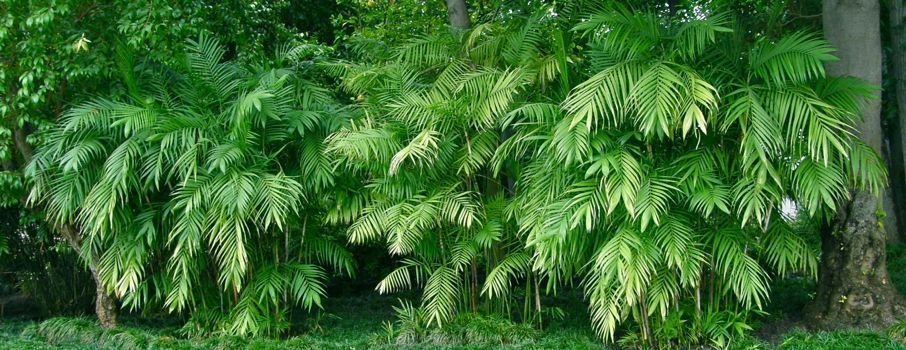
Chamaedorea seifriziis used as landscape plants in nice neighborhood, Los Angeles, California
Chamaedoreas are pinnate palms with green, bamboo-like, ringed stems. Most are smaller palms, but some grow up to over 20'. Some are suckering palms and some solitary stemmed. All Chamaedorea are dioecious (plants are either male or female, never both). In general they are moisture-loving palms with little tolerance for bright, hot sunshine (a few exceptions exist) or freezing cold (again, there are a few exceptions). They have a remarkable tolerance for low light which makes many of them ideal house plants. Some have marked humidity requirements, however that keep them from doing well in homes in all but the most humid of climates. They are in general easy to grow palms with low fertilizer needs and few other serious diseases (though many are prone to snail damage in the garden and to spider mite infestation indoors). Their ease of growth, low cost and small size make them very popular plants.
The species:
Chamaedorea adcendens- this Guatemalan palm (also from Belize) is easily one of my favorite species, being very ornamental, ideal for most southern California climates and tolerant of a wide variety of conditions from low light, to moderate sun exposure, cold down to about 25F, heat (under 100F), somewhat drought tolerant and easily one of the most snail resistant of all the Chamaedorea. It is a smaller plant, usually only growing up to 3' tall in cultivation, with sea-green, somewhat rough and leathery irregularly pinnate leaves. The undersides of the ovoid leaflets are an ornamental glaucous coloration. This is a relatively slow growing species and does very well in a pot for many years. These solitary plants take up little room and look great in small colonies in the garden. Colonies of 3-4 or more may insure one of having at least one of each sex, and then one can propagate these beauties and have many seedlings to give to friends later (propagation does require one to be the fertilizer, as the native insect fertilizers rarely exist in cultivation).
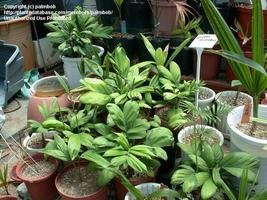
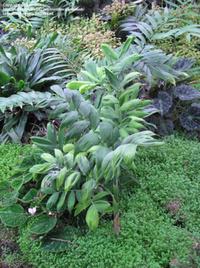
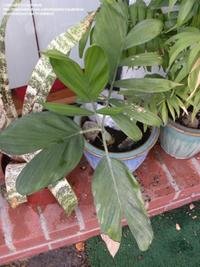
Chamaedorea adcendens in tropical climate (Taiwan), in garden in California, and my own in pot in California
Chamaedorea amabilis- though a beautiful palm and certainly worth growing in large numbers, this is one of the finickier of the Chamaedoreas we can grow here in southern California. It is not a very cold tolerant one, and has very high humidity requirements. But it is hard to beat for ornamental value. It has bifid (fish-tail shaped, unsplit pinnate) deep green leaves with prominent parallel ridges. The lateral leaf margins are parallel as well and the leaves are not much longer than they are wide (compare to most other bifid Chamaedoreas that have either longer leaves or are more wedge shaped). The stems are quite thin and closely ringed, curving and bending gracefully with age. This species does tend to brown tip easily with poor water quality, high heat and low humidity, so it does far better along the coast or in protected microclimates inland. It does not do well as an indoor palm unless misted every day. These palms originate from Costa Rica, Colombia and Panama.
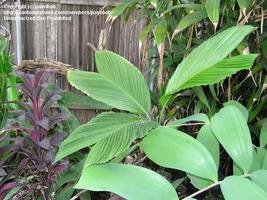
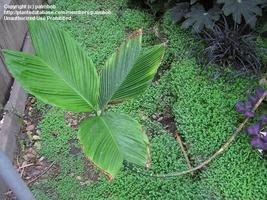
Chamaedorea amabilis in Southern California
Chamadorea arenbergiana- this Central American native is one of the taller and faster growing species and a very ornamental one for the garden. Starting out as a bifid species for several years, it soon grows into an ovoid, pinnate palm with large and very wide, somewhat leathery leaves with prominent ridges. The trunk is about 1" in diameter and very bamboo like with prominent rings. This is not a palm that tolerates much sun or wind and tends to look ratty if exposed to the elements. Cold hardiness is poor with temps below 28 damaging the leaves, and temperatures below 26F often resulting in death. My palm grew from a 8" seedling to 4' in just 3 years, but then a freeze killed it. I haven't had the heart to replace it yet.
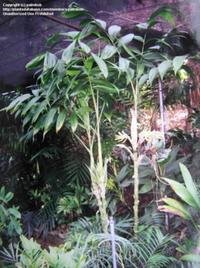
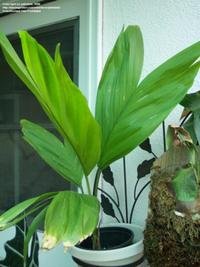 Adult & young Chamaedorea arenbergianas, CA
Adult & young Chamaedorea arenbergianas, CA
Chamaedorea benziei- one will not find much about this palm in Hodel's book as it does not appear to be the same palm as listed in the book as a synonym of Chamaedorea carchensis. It has yet to be officially described as far as I know. It is a great palm for both southern California and Florida though currently it is difficult to acquire. In the 90s this was a fairly common palm and it was distributed all over the southern US, presumably from one large importation of seed. It is a large palm for a Chamaedorea, but it does not appear to be as tall as it was expected to grow. Stems are about 1.5" in diameter and the leaves are long and arching with widely spaced lanceolate thick leaflets. Flowers seem to arise from below ground level and plants only 3' tall have large upright flowers nearly as tall as the entire plant. This species has good cold tolerance handling temps in the mid 20s with few problems. It does fairly well in partial sun and has some wind tolerance as well.
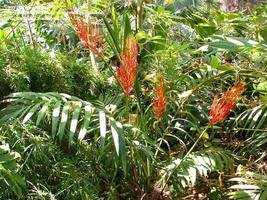
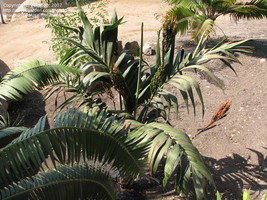
Chamaedorea benzieis in Florida in shade, and California in a lot of sun
Chamaedorea brachypoda- this species is a commonly grown species in both California and Florida outdoors (sometimes indoors, too), but is a far better plant for Florida than California. It is a suckering, bifid species that spreads by underground rhizomes and eventually forms dense colonies of low-growing bifid-leaved plants on skinny stems of about ¼" in diameter. This is one of the few invasive Chamaedoreas so that has to be taken into account before planting. It has moderate cold tolerance (27F) but poor sun and low humidity tolerance. Colonies of this growing in Florida tend to look dark green and lush, while in California they often look yellowy, brown-tipped and tattered by the arid winds. It is an excellent plant for pot culture growing into very densely packed colonies with little ill effect, often doing well in the same pot for many years. Chamaedorea brachypoda is native to Guatemala and Honduras.
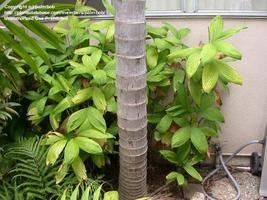
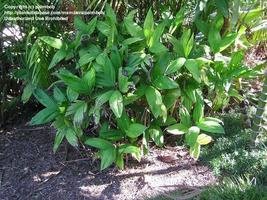
Chamaedorea brachypodas in California- one on left is more typical sad, yellowy plant, while one on right is unusually green for California
Chamaedorea cataractarum, the Cat Palm- anyone visiting a large garden outlet center in the southern states (and perhaps elsewhere as well) will see many of these palms as they are currently one of the most popular palms in cultivation. This is a very upright, closely suckering species of deep green that performs very well both in the garden and in pots indoors and out. In its native Mexico this is a true rheophyte growing in constantly moist situations and even being complete submerged in rainy season without apparent ill effects. Fortunately one does not need to plant this species underwater for it to do well in cultivation, but it certainly is a difficult species to overwater. This is a species that performs equally well in hot humid climates as it does in the arid climate of southern California. Cold tolerance is moderate with burning of leaves at around 26F. However plants will often survive much more severe colds growing back from the roots and partial stems that were not killed during a freeze. It is not a very drought tolerant species and will look sad if not watered well. Sun tolerance is surprisingly good, though plants grown in full, inland sun tend to look stunting and yellowy much of the year.
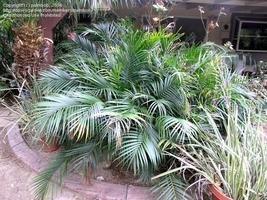
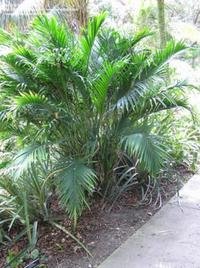
Both photos are of Chamaedorea cataractarum- one on left in full sun and one on right in fairly deep shade
Chamaedorea costaricana is another relatively common and popular species, but not so common that one would likely find it at a Home Depot or Lowes. This is a tall, suckering palm often referred to as the bamboo palm (though a common name for about 10 other species of Chamaedorea as well) thanks to its thick, straight, tall, green ringed stems that look very much like bamboo culms. This species can grow up to 20' tall in shade but usually a bit less so in sun. It does tolerate some full sun, though prefers some shade in inland, hot climates. Chamaedorea costaricana is a variable species from Costa Rica and a few other Central American countries, and sometimes telling it apart from other similar species is a challenge. And many species have been described that have eventually ended up being this. Chamaedorea potchutlensis is nearly identical to this species but does not have ‘ligules' on its leaf bases (a ligule is a squiggly appendage about an inch long that rests against the stem like a flange- it's the best I can do to describe it). It is a good species to use as a visual screen or for larger areas of the garden, as clumps can extend up to 15' or more wide. It does well in pots, but is not an ideal indoor species (a bit too needy of bright lights and seems particularly susceptible to spider mites). Cold hardiness is moderate down to about 25F. This plant is native to southern Central America.
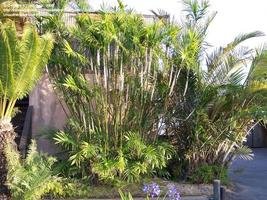
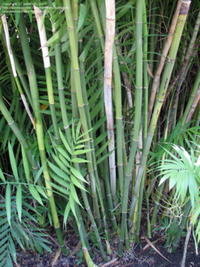
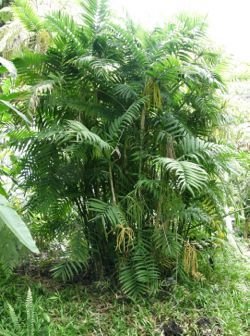
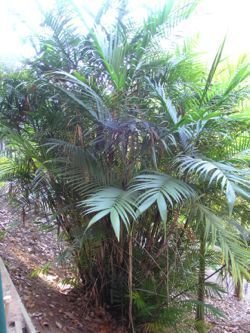
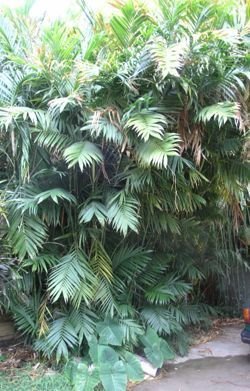
Colonies of Chamaedorea costaricanas, all in California
Chamaedorea deckeriana is a beautiful, solitary, thin-stemmed bifid species with large, light green, ribbed leaves. This Costa Rican and Panamanian native is one of the more impressive bifid species, but a fairly cold sensitive one as well. Growing this one in southern California without it looking stressed or unhappy is a challenge. I personally have not been able to keep one alive in zone 9b, but I have seen a few fairly nice plants in zones 10a and 10b (still, there are hardier and much easier species, most notably Chamaedorea ernesti-augustii and metallica). http://www.plantapalm.com/Vpe/photos/Species/chamaedorea_deckeriana.htm This is a link to a page with a photo of mine on it on the Central Florida Palm Society web site.
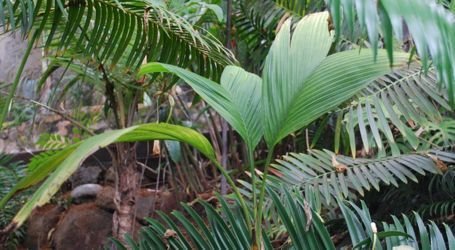
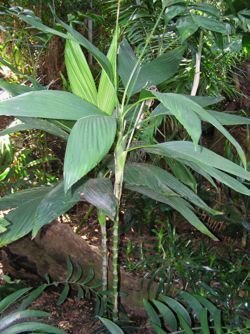 Chamaedorea deckerianas in So Cal
Chamaedorea deckerianas in So Cal
Chamaedorea elatior is the only vining Chamaedorea species and is a native of Guatemala and Mexico. This is not a commonly grown ornamental even though it is a pretty easy plant to grow in the right climate (most climates in southern California will support this plant well as long is plenty of shade exists) presumably because of its vining nature. However, as a young plant is exceptionally attractive in the entire-leaf stage of it's life (before it starts to develop long, twisting leaves). Some forms retain the unbranched leaves for years before vining. Chamaedorea elatior is also one of the few true branching palms (I made this discovery on my own and thought I had found some unique palms when I later read this is common in this species in Hodel's book). The mature palm is definitely one grown for the sake of collecting odds and ends as it is hardly a good looking plant, sprawling all over the surrounding vegetation and structures, twisting in messy clumps of bamboo-like leaves, or just collapsing and crawling messily along the ground. The leaf ends are a fascinating shape somewhat similar to those seen in some other climbing palms (the rattans) and have leaflets that hook backwards near the ends of each leaf. Though not a great looking palm, it is a good one to hybridize with and many hybrid Chamaedroea elatiors make good garden specimens. It is a relatively cold hardy species, tolerating temps down below 25F briefly, but it not a good sun or indoor plant.
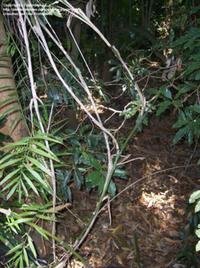
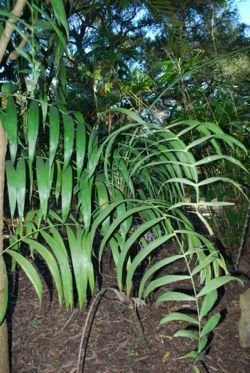
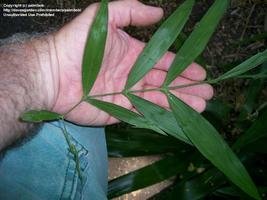
Chamaedorea elatiors in California. Left photo shows branching, center general leaf shape of mature plant, aand last shows 'reverse' leaflet direction used in climbing/ holding on to surrounding vegetation
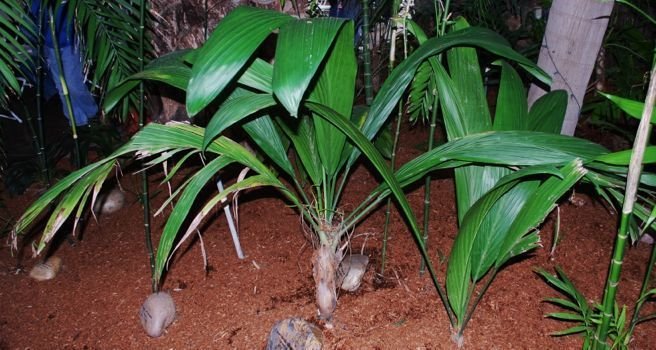
Immature Chamaedorea elatior plants showing very large, bifid leaves- looking almost like an entirely different species
Chamaedorea elegans is probably the most commonly grown Chamaedorea, if not the most commonly grown palms in cultivation. This is also known as the Parlor palm and is easily one of the premiere indoor palms, succeeding beautifully as one for many decades, often in the same pot rarely ever outgrowing its situation. This is a solitary stemmed palm with very closely spaced rings (thanks to its relatively slow growth). It can grow up to 10' tall, but takes a long time to get there, and rarely does indoors. It does not do well in full sun normally, but is amazingly tolerant of low light situations. Additionally, though it prefers a lot of moisture, these palms can tolerate an amazing amount of drought abuse, often gradually losing leaves as a warning that it's time to water before it dies. Outdoor aged plants often start showing some twists and turns in the stems and get sort of spindly looking and less ornamental. It is a native of Mexico, Guatemala and Belize.
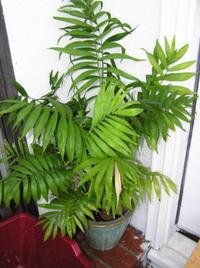
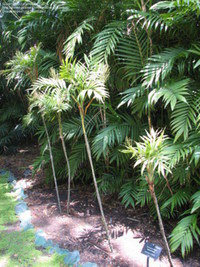
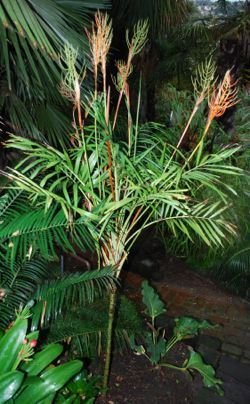
Chamaedorea elegans in pot and as an older outdoor palms in southern California
Chamaedorea ernesti-augustii is one of the two easiest of the large-leaf bifid Chamaedoreas to grow, having better than average cold tolerance, amazing resistance to spider mites and performing admirably as an indoor plant. It is a solitary stemmed plant with very large bifid leaves (up to 2' long and nearly as wide), and tends to hold an relatively large number of leaves at a time relative to most other bifid-leaved Chamaedoreas. It is a slow species when small, but a relatively common one in the special nursery trade, so getting a larger one is not difficult or too costly. This plant is native to Mexico and several other Central American countries.
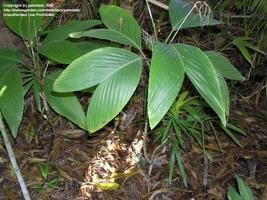
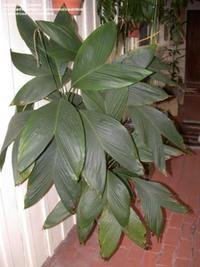
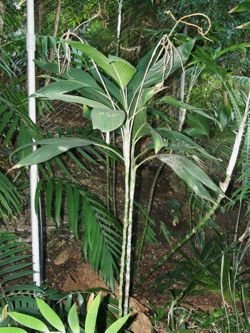
Chamaedorea ernesti-augustiis in landscape (left and right) and as house plant (center photo)
Chamaedorea fragrans is one of the more sought after species and large specimens can be quite costly. It is an exceptionally ornamental species but a bit touchy to grow in all but the warmest areas (cold tolerance is barely under freezing). It also has a low tolerance of arid winds and poor water quality. But if you live in the right climate for this species (not too hot and not too cold- coastal protected California and warm but not baking hot tropical climates are great) it is a wonderful ornamental with many straight, narrow stems and thin, elegant bifid leaves and various heights along the stems. It forms tight clumps and rarely outgrows its area. This is a pretty thirsty palm.
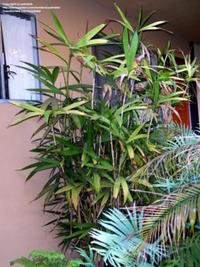
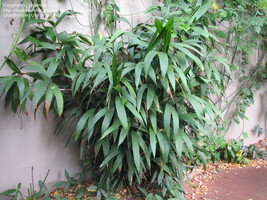
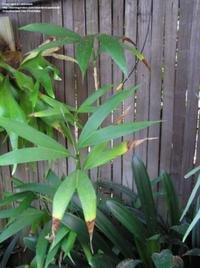
Chamaedorea fragrans in protected coastal climate, Southern California; in a conservatory, and close up of outdoor leaf in Los Angeles
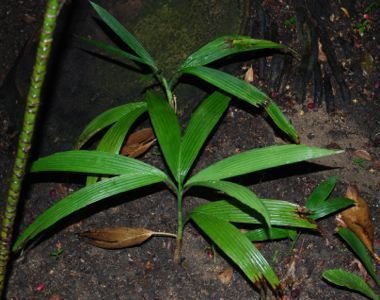
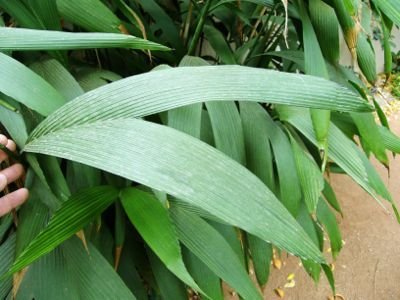
immature plants in garden (southern California)- left; right is a close up of the leaf shape of Chamaedorea fragrans
Chamaedorea geonomiformis: While Chamaedorea ernesti-augustii is one of the premiere large bifid Chamaedoreas, this is one of the easiest and most attractive small leaf bifid Chamaedoreas. This is one of the few Chamaedoreas with a common name (the Necklace Chamaedorea) so named thanks to its bifurcating, jewel-like draping flowers. It is a low growing species rarely getting up to even 3' tall (though sometimes even taller) and holds a relatively large head of parallel-sided bifid long leaves (often more than 10 leaves per plant... a lot when one considers most bifid species usually have 3-5). Some consider Chamaedorea tenella a form of this species, but it is quite a bit smaller and daintier, so I have it listed separately. This species can be found in most Central American countries, and is usually available at most palm nurseries.
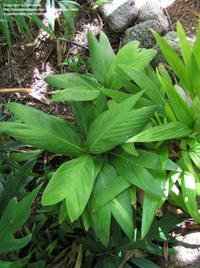
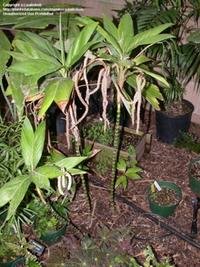
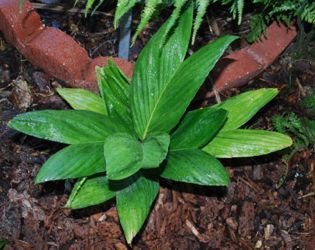
Chamaedorea geonomiformis in Southern California. Older plants in center photo showing the 'necklace' infructescences
Chamaedorea glaucifolia: this is one of the few species that seem to tolerate a good deal of hot inland sun, though still prefer some protection from searing mid-day arid sunshine. It is a solitary stemmed moderately fast growing species up to 15' tall with very thin, spread out and plumose leaflets with a slight glaucous bloom on them. Some do not consider this the most ornamental of species and often prefer Chamaedorea plumose to this. Cold tolerance is down to around 25F with significant burn below that, though it may survive temps briefly several degrees colder.
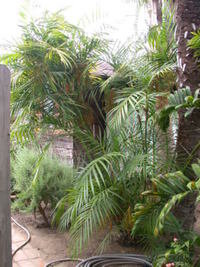
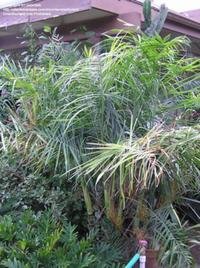
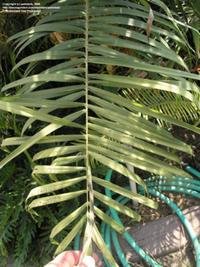
Chamaedorea glaucifolia in partial sun; a full sun clump of palms, and leaf detail, all in California
Chamaedorea hooperiana is one of the best and most attractive of the moderate sized clustering Chamaedoreas. It has slightly curving stems that arise densely from a small area and swoop outwards and upwards. Usually these stems arise just about ground level unlike many of the other clustering species in which the stems shoot out of the soil at varying distances from the primary plant. Leaflets are long and narrow and dark green. This is a good indoor species as well as a fine outdoor one, though cold hardiness is only modest at about 27F. It is a Mexican species named after one of the more active growers of palms in southern California, Louie Hooper. This is one of the more commonly sold Chamaedoreas from specialty nurseries and I have seen it often sold by other nurseries as well.

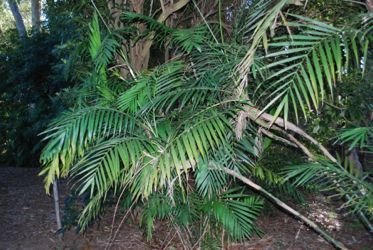
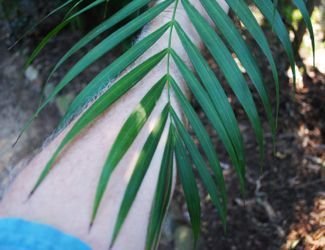
Older Chamaedorea hooperianas (left and center photos), and leaves of a younger plant (right photo)
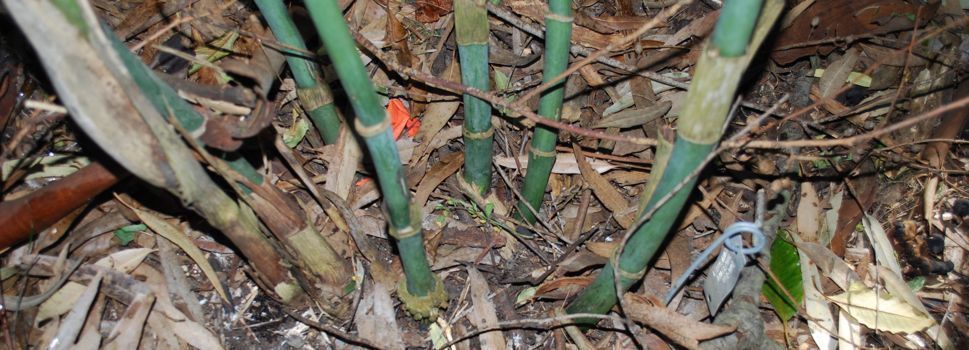
Base of Chamaedorea hooperiana, showing the angled eruption of stems from the earth- they almost make a swooping shape as they start growing upright
Chamaedorea klotzschiana is one of the hardest species to spell correctly, but a great palm for my area of southern California. This Mexican species is a solitary, moderately thick-stemmed, fast-growing species with a unique ‘bow-tie' arrangement of leaflets (some call this the Bow Tie Chamaedorea, though that is NOT an official name for it). This species grows up to 12' tall, though the taller it gets, the less ornamental and interesting it becomes. I have grown this species a number of times and it seems hardy to about 27F. This is NOT a good sun palm and suffers from excessive (which can be any) sunlight. It is also one of the tastier palms from a snail's point of view. Most palm nurseries have this plant in their inventory.
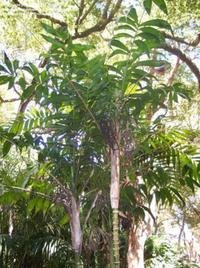
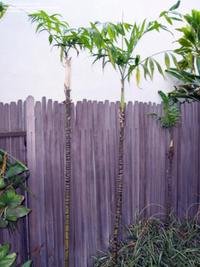
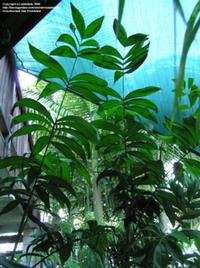
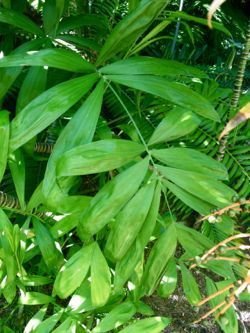
Chamaedorea klotzschianas in southern California
Chamaedorea linearis is one of the larger Chamaedoreas growing up to 30' tall. It is a solitary fast-growing species with gracefully arching pinnate leaves and a large, thick, ringed, light-green to yellow-green trunk. It is not that common in cultivation but should be. This is a South American species. Finding this plant for sale is a challenge.
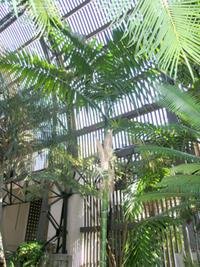
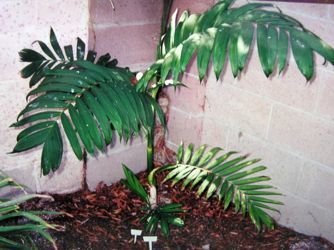
Chamaedorea linearis in southern California in protected lathe house (left); outdoors as a younger plant (right)
Chamaedorea metallica is another very common and popular species with uniquely shiny, almost metallic looking bifid leaves. This is a solitary Mexican species and is popular not only thanks to its thick shiny leaves but also due to its ease of growth in pots both indoors and out. Cold tolerance is not great with severe damage or death at around 27F, nor is it happy in full sun except along the coasts or in very humid cooler tropical climates. Some forms of this species have regular pinnate leaves and for some reason those are often sought after despite their being far less ornamental than the bifid forms (collectors always want the rarer versions of everything). This species is somewhat resistant to spider mites and does well in very low light situations making it one of the better indoor palm species. This is a fairly common plant and even many non-specialty nurseries will sell this one (though usually at ridiculously elevated costs).
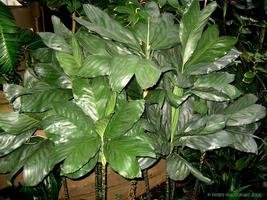
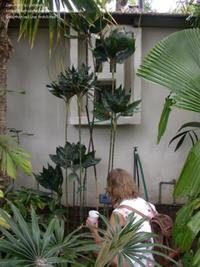
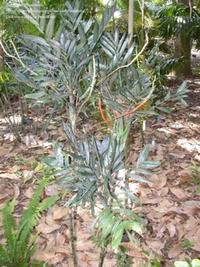
Chamaedorea metallicas- first photo by Kell. Second of very old, taller plants in California, and last of split leaf forms in Florida
Chamaedorea microspadix is another common plant in cultivation but more for reasons of its tolerance to cold more than as its use as a house plant. This is a suckering thin-stemmed drooping-leafed species with nearly ovoid to lancelote leaflets and brilliant red fruits. This is one of the more sun tolerant species with some varieties tolerating full inland sun with only slight yellowing of the leaves. Still, it looks better and healthier in some or complete shade. Cold tolerance is remarkable for such a tropical palm (Mexican species) with palms surviving the low 20s with minimal damage, and, thanks to its suckering nature, even colder temps that might cut down the entire plant, as it will often come back from the roots and buried stems. It performs as a house plant but is quite susceptible to spider mites, so is not ideal.
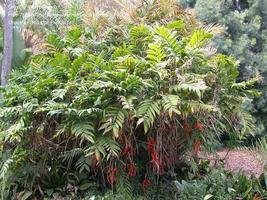
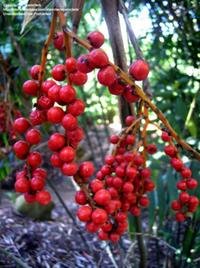
Chamaedorea microspadix colony in southern California, the fruit- this is one of the most reliable fruit producers of all the Chamaedoreas
Chamaedorea nationsiana: This solitary pinnate leaved Gautemalan palm was fairly rare in cultivation until recently. I tried this species in my garden assuming it would croak as so many of the rarer Chamaedoreas do in inland Southern California... but was surprised to see it do very well, having good cold tolerance to about 28F and only modest wind intolerance (this species has large, long ovoid leaflets, sort of like C arenbergiana that don't particularly relish arid winds sucking out their moisture). Though once pretty rare, this one is now available from many palm specialty nurseries.
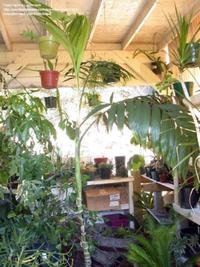
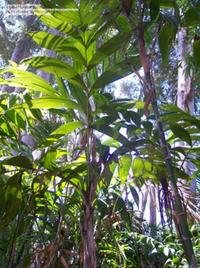
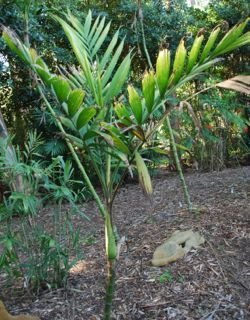
Chamaedorea nationsianas in California
Chamaedorea oblongata is a great species for cultivation. It is a highly ornamental solitary stemmed species with striking, dark-green, shiny ovoid leaflets on arching leaves atop a skinny, green ringed stem about ½" in diameter. This palm is easy to grow and its narrow shape makes it easy to grow in many areas of the garden. It is not a sun-lover, so at least half day shade is needed, and cold hardiness is only down to about 28F (mine totally defoliated at 27F, but surprisingly grew back even after the spike pulled out). This is the best of the tall, solitary ovoid-leaved Chamaedoreas in terms of ease of growth and mite resistance. Even some non-specialty nurseries will carry this species.
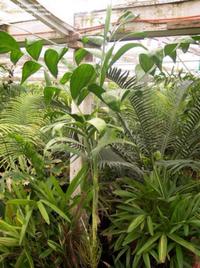
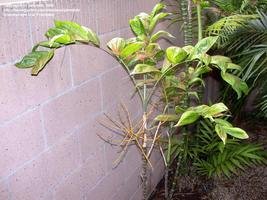
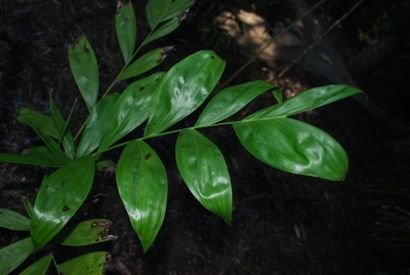
Chamaedorea oblongatas in California
Chamaedorea oreophila is one of my personal favorites mostly because it is not that common but it's surprisingly hardy and easy to grow as well as ornamental. This species is a solitary pinnate leaved plant that looks superficially like Chamaedorea elegans, but with a more robust appearance and growth rate. The leaves are more leathery and the leaflets a bit longer and narrower. It also has some of the most striking flowers and fruits. This species has good cold hardiness for a Chamaedorea, down to at least 25F with minimal foliar damage. Some claim it does well indoors. It supposedly is sensitive to thrip infection, though I have not noticed that. I have a Chamaedorea seifrizii near mine that is always struggling with thrips yet the Chamaedorea oreophila is unaffected. This is a relatively uncommon species, but usually available from palm nurseries.
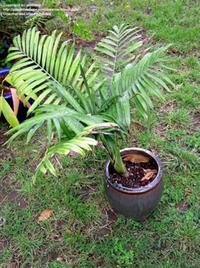
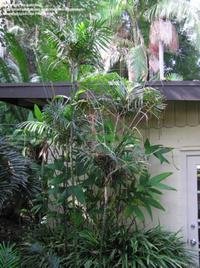
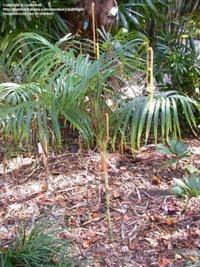
Chamaedorea oreophila (mine in pot); old plants in California, and a solitary one in botanical garden
Chamaedorea pinnatifrons is one of the most variable of the Chamaedoreas having dozens of synonyms in the literature. It is a single-stemmed tall palm that looks a lot like a thin-leafed Chamaedorea oblongata, but I gather it can look different from that, too. It is currently grown in cultivation, but usually under different names, and plants sometimes identified as this end up really being Chamaedorea oblongata. Because of the massive confusion about this species, I have no personal experience with it... I think. I am not sure about cold hardiness but it is supposed to be average- probably about 27F is its limit.
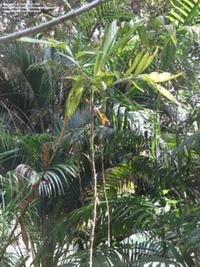
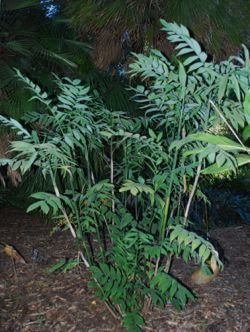
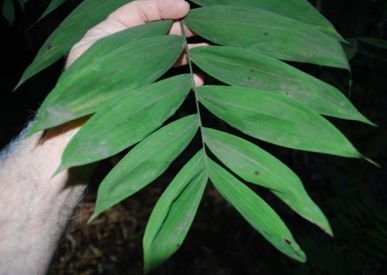
poor photo on left but I do not see too many of these; center is probably best representation of Chamaedorea pinnatifrons in California that I have seen; right is shot of leaflets
Chamaedorea plumosa is a species one won't find in Hodel's book on Chamaedoreas as it was described afterwards. For a recent discovery, it has already become quite a common and popular palm. It is probably the best of all the Chamaedoreas in terms of tolerating full, inland sun (though it tolerates shady conditions as well), and one of the faster growing of them. This is a tall, solitary species with a thick trunk, up to 2" in diameter, topped with a sparse arching crown of very thin, plumose (leaflets in various orientations) leaves. It looks like a stout, taller version of Chamaedorea glaucifolia. Cold hardiness is fair (26F) but it seems exceptionally hardy to hot, drying winds. It's a bit tall and sparse to make a great specimen palm, but looks good planted in groups or along side buildings. This is not a rare palm and most specialty nurseries, along with a few non-specialty nurseries often carry it.
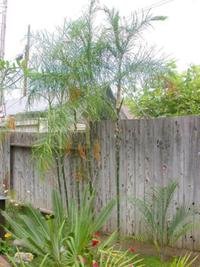
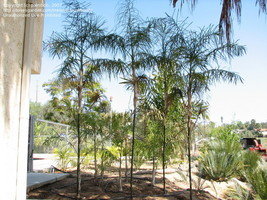
Chamaedorea plumosas in Southern California
Chamaedorea potchutlensis: I have a hard time identifying this Mexican palm accurately as well. It is a suckering, tall species with many narrow leaflets and bamboo-like stems. This palm looks exactly like a Chamaedorea costaricana and has the same cold tolerance (about 26F) and cultivational needs. Both tolerate more sun than most Chamaedoreas and grow about the same rate. Chamedorea costaricana may be a tad more robust, but you really need to look for the ligules (see Chamaedorea costaricana) to tell them apart. But it is a great palm for outdoor visual screens, indoor pots and as a nice specimen plant in a slightly to very shady garden. Finding this species for sale is not all the easy now, though it must have been common once since so many botanical gardens have large, old plants.
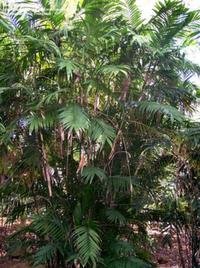
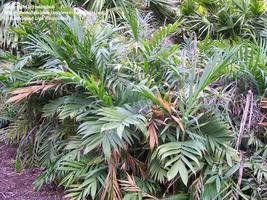
Mature palms in California (one in shade, one in full sun with some tall canes removed)
Chamaedorea radicalis is one of the most cold hardy of all the Chamaedoreas, and is fairly tolerant of sun and heat as well. This Mexican leathery-leaved dark green to nearly blue-green plant is a solitary species that comes in two fairly distinct forms (though some inbetween plants are sometimes encountered)- stemless or ‘tree'-form (tall, thin stems up to over 15' tall). It produces attractive red fruits whether fertilized or not and is quite an ornamental species, and a common, easy to find one as well. Few palms resist spider mites better than this one, and Chamaedorea radicalis manages somewhat as an indoor plant. However, it has much higher light needs than most other species and sometimes suffers from too-dark indoor environments.
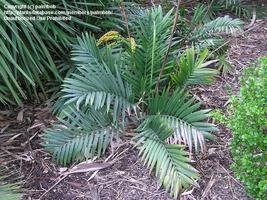
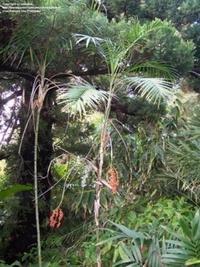
Chamaedorea radicalis non-tree form, and tree forms, in California
Chamaedorea sartorii is a Mexican palm that has a lot of similarities to Chamaedorea oblongata, though perhaps holding just slightly longer leaflets. However the leaflets are fairly wide- almost ovoid, dark green (maybe slightly darker than C oblongata) and fairly leathery. The solitary stem is similar in appearance though perhaps a tad thinner than in Chamaedorea oblongata. The flowers are different, but that is a discussion to be taken up with texts on these palms as flower morphology is a tad technical to me. Chamaedorea sartorii is not all the common in cultivation, though examples of it can be found in the usually states and countries other Chamaedorea grow in, but just not in private gardens all the often.
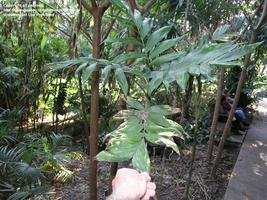 Chamaedorea sartorii
Chamaedorea sartorii
Chamaedorea seifrizii (another species called the Bamboo Palms) is one of the most commonly grown and available Chamaedorea species in cultivation, primarily since it is so easy to grow and performs so well as an indoor palm. This palm comes from Mexico and several other central American countries in both swampy areas and surprisingly seasonally arid locations (Hodel says it's one of the most drought tolerant of all the Chamaedoreas). This is a tightly clustering, highly variable species with narrow to wide pinnate leaves arising off perfectly straight stems that, with time, can create a nearly solid barrier of closely spaced green, ½" sticks. There is so much variability in the leaf shape the Chamaedorea erumpens, a synonym, is often sold separately even by palm specialty nurseries as the wide-leaf form of this species. This palm is fairly tolerant of both extremely low light situations as well as adapting to some degree to hot, inland sun (never looks great in full sun, though). Filtered light seems to be the ideal situation for it. It is also one of the more resistant indoor palms to spider mites. This palm can be found at nearly all nurseries that sell indoor foliage.
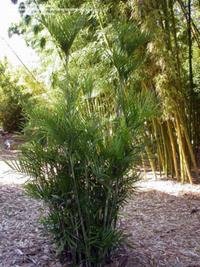
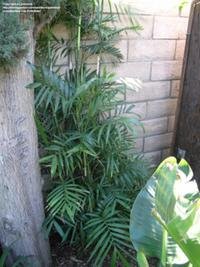
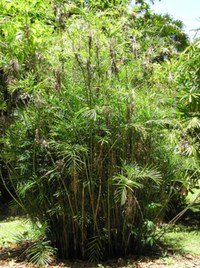
Chamaedorea seifriziis in California Chamaedorea seifrizii in Hawaii
Chamaedorea stolonifera is one of my favorite species, mostly because it almost always looks good, either indoors or out. This bifid, suckering (spreading by stolons, either above ground or just below the surface) palm has narrow stems up to 4' tall and ‘medium-sized' leaves with parallel sides of dark green and a leathery texture (compare to the thin-leaved, paler Chamaedorea brachypoda). This species has moderate cold tolerance down to about 27F, though freezes down to 24F will rarely kill it dead as it has a tendency to regenerate from the root stock (at least that's what happened to my palm during the 2007 freeze). As a garden plant, it tends to spread slowly, but constantly filling smaller areas with twisting to upright little palms in a not-too-dense style. Some might consider it an invasive species, but it's so slow growing and easy to cut (thanks to the mostly over-ground stolons) that it's fairly easy to contain. In a pot it tends to form ornamentally twisting and arching stolons above the soil, often forming small suckers that grow just outside the rim of the pot- a very attractive look. This is not a rare species and can be found at most palm nurseries.
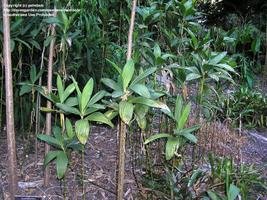
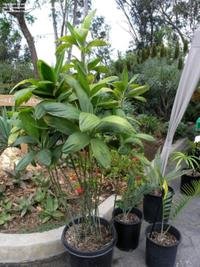
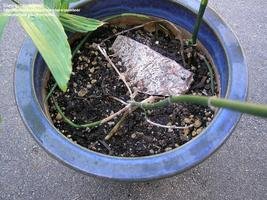
Chamaedorea stolonifera colony, and large, potted plant. Last photo shows stolons in a small pot
Chamaedorea sullivaniorum: this short, bifid, single-stemmed species from Panama, Costa Rica and Colombia is often considered a collector's item due to it's rarity, beauty and difficulty in growing (at least here in Southern California). The leaves of this species are either a bright green or a dark bluish-green with mottling, both color forms with prominent ridges. In an arid climate such as southern California, this tropical rainforest species tends to be difficult to keep from brown tipping and does not hold too many leaves at a time (3-5 at the most)... yet in a tropical setting 10 leaves are not unusual. Some palm nurseries carry this palm, but it is an expensive one. It is named after one of the most well known and loved palm growing couples, Pauleen and Joe Sullivan.
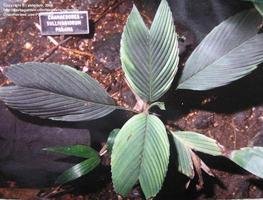
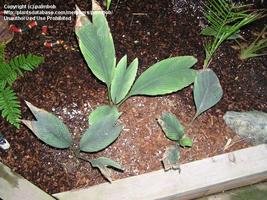
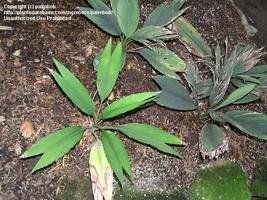
Chamaedorea sullivaniorums in 3 different gardens in southern California. Last photo shows rare green form, too. Note tattered, shredded leaves from snails and lack of humidity
Chamaedorea tenella: Some consider this species a synonym of Chamaedorea genonomiformis, but it sure seems to be significantly different for me to list it separately. There are two distinct forms of this species, one with flat bifid leaves, somewhat like a miniature Chamaedorea geonomiformis, and one with curled leaves. The form found in Chiapas tends to have leaves that are flat, and very shiny with subtle ‘teeth' along the leaf margins. This is also similar to the form found in Costa Rica. Veracruz palms tend to hold less leaves, and the leaves are shorter and curled down at the tips.. they also seem a bit more leathery and less shiny. This is a wonderful little palm to spread about a shady garden and fairly easy to grow. Cold tolerance is about 28F, but being an understory palm, most don't see this low a temp unless the surrounding temps are much lower. This species may do well as a house plant, but I have no experience with it as one.
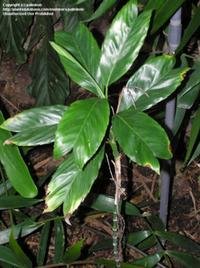
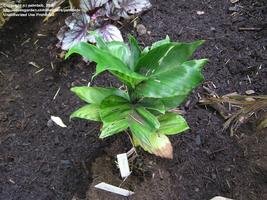
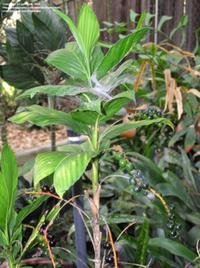
Chiapis form of Chamaedorea tenella, and two photos of the Veracruz form, all in Calilfornia
Chamaedorea tepejilote: This is a solitary, or sometimes suckering species from both Central and South America, growing upwards of 20' tall on thick, bamboo-like trunks. The leaves of this species are thin but wide, ribbed and tend to hang down a bit. There is a prominent yellow line along the underside of the petiole that makes this species easier to identify, as there are several tall, solitary pinnate Chamaedoreas. It is a fast growing species and a wonderfully graceful, ornamental species. However it has very poor full sun tolerance so needs to be grown in a tall canopy or it will eventually grow through a lower canopy and start to burn. This is not a rare species and most palm specialty nurseries typically have this one in stock.
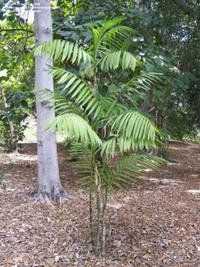
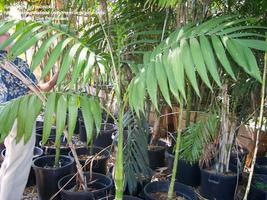
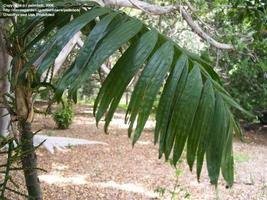
Chamaedorea tepejilotes
Chamaedorea tuerckheimii is one of the hardest species to spell or say correctly. It is a wonderful little solitary rainforest species from Guatemala and Mexico with very ornamental thick, deeply ribbed bifid leaves. There are two forms of this species as well that correspond with their geographic locations. The Mexican form is a larger, leafier form with lighter, mottled leaves and is one of the most ornamental of all miniature palms. The more common form in cultivation, however, is the dark green Guatemalan form with a whitish border around the edges of the leaf- these leaves look very much in shape and texture like a Ruffles potato chip (hence its common name, the Potato Chip palm). Both forms are highly sought and pricey, but are very needy in terms of humidity, good water quality and moderate temperatures... .so plants grown in arid climates or hot or cold ones don't tend to look good most of the time (lot of brown leaf tipping or only holding a few healthy leaves at once). Due to is humidity requirements, it does not do well as an indoor palm.
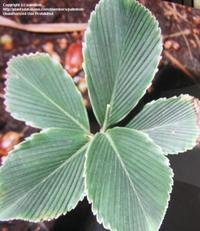
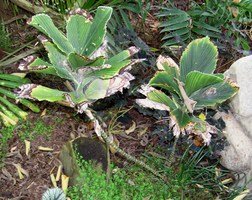
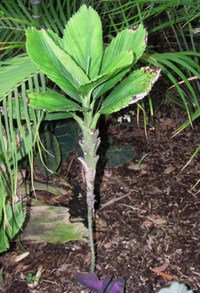
Guatemalan forms of Chamaedorea tuerckheimii in first two photos, and Mexican form in third and at top of article
Chamaedorea woodsoniana is probably the largest of the Chamaedorea growing up to 35' tall and with a trunk up to 4" in diameter. It is an impressive bamboo-like solitary species with large pinnate leaves with long, lancelote leaflets that tend to be held in an upright V shape. It is a fast growing species and fairly adaptable, though not too tolerant of full sun (again, the problem of growing this palm in low canopy situations exists). There was some early confusion about what this species was and that confusion persists to this day. Though not a super rare plant in cultivation, many sold as this are actually something else (first clue is when that something else starts to sucker)- usually Chamaedorea costaricana. There is little information on this palm as an indoor palm, and probably it would be unsuitable as one but in the tallest and most humid enclosures.
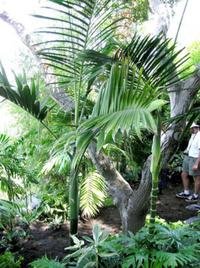
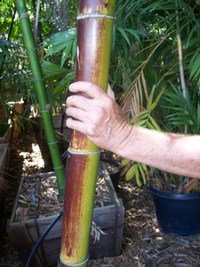 Chamaedorea woodsoniana in California
Chamaedorea woodsoniana in California
There are many other species of Chamaedorea, some in cultivation here and there, and some not, but the above species are the ones most likely to be encountered by most growers and collectors. It is a wonderful genus and every garden in a suitable climate should have some! And those not in suitable climates should at least have some as house plants.
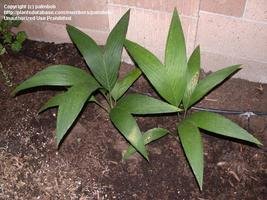
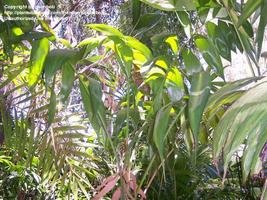
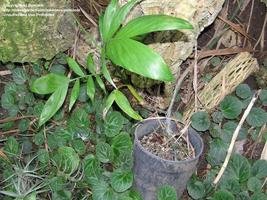
Chamaedorea rossteniorums in the Rossten's garden, the growers who these palms were named after; Chamaedorea peduncuala and Chamaedorea rhizomatosa
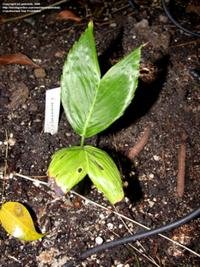
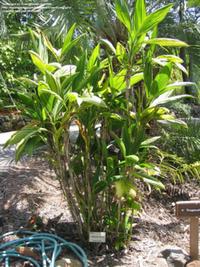
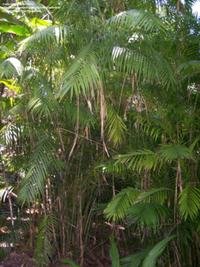
Chamaedoreas deneversiana and nubium in California gardens; Chamaedorea 'Irving Cantor', a popular hybrid of Chamaedorea pochutlensis and graminifolia, in public California garden (thank you to GreenEyedGuru for photo of Chamedorea nubium)
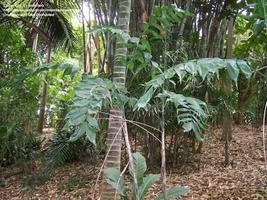
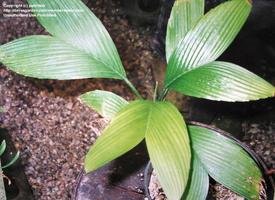
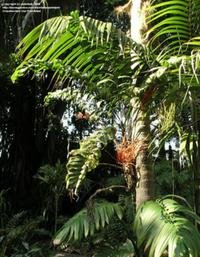
Chamaedorea scheidiana (a Chamaedorea oblongata look-alike, but with more papery leaves), Chamaedorea verucunda in a greenhouse, and Chamaedorea whitelockiana (another palm named after a well known palm and cycad collector)
Copyright © www.100flowers.win Botanic Garden All Rights Reserved